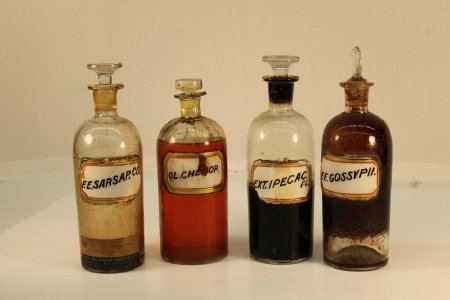Object ID Number:
PH156
Object Name:
Bottles
Type:
Shop Furniture
Manufacturer:
Unknown
Manufactured from:
1820
Manufactured to:
1850
Description / History:
Set of four pharmacy bottles. The bottles are made of clear mold blown glass. Each bottle is has a white label, lined in gold, affixed to the bottle with a thin piece of clear glass.
Bottle A. Labeled Ol. Chenop. Oil of Chenopodium was used by 19th century doctors to treat intestinal worms. It would paralyze the worms and since it was also a potent laxative, was effective in flushing the worms from the body. However, it was later found to be very toxic and can irritate the skin, mouth and throat. It also causes vomiting, headache, dizziness, kidney and liver damage, convulsions, paralysis, and death.
Bottle B. Labeled Ext. Ipecac. Fl. Ipecac has a long history as a powerful emetic for emptying the stomach in cases of poisoning. It was first used as early as 1653 and was used until late in the 20th century. In the 19th century, women prisoners were given ipecac as a precaution to treat their temperment. Whild ipecan could often be found in most households with children in the 20th century in case of accidental poisoning, doctors now discourage its use.
Bottle C. Labeled F. E. Gossypii.
Bottle D. F. E. Sarsap. Co. Also called sarsaparilla, this was used to treat syphillis and other sexually transmitted diseases. Other uses was for the treatment of arthritis, fever, digestive disorders, leprosy, and cancer.
Bottle A. Labeled Ol. Chenop. Oil of Chenopodium was used by 19th century doctors to treat intestinal worms. It would paralyze the worms and since it was also a potent laxative, was effective in flushing the worms from the body. However, it was later found to be very toxic and can irritate the skin, mouth and throat. It also causes vomiting, headache, dizziness, kidney and liver damage, convulsions, paralysis, and death.
Bottle B. Labeled Ext. Ipecac. Fl. Ipecac has a long history as a powerful emetic for emptying the stomach in cases of poisoning. It was first used as early as 1653 and was used until late in the 20th century. In the 19th century, women prisoners were given ipecac as a precaution to treat their temperment. Whild ipecan could often be found in most households with children in the 20th century in case of accidental poisoning, doctors now discourage its use.
Bottle C. Labeled F. E. Gossypii.
Bottle D. F. E. Sarsap. Co. Also called sarsaparilla, this was used to treat syphillis and other sexually transmitted diseases. Other uses was for the treatment of arthritis, fever, digestive disorders, leprosy, and cancer.
Dimensions:
H–9 Dia–2.75 inches
